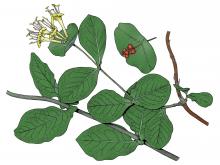Trees, Shrubs and Woody Vines
Media

Species Types
Scientific Name
Maclura pomifera
Description
Osage orange is a densely branched, short-trunked, thorny tree. It bears weird-loooking, softball-sized, chartreuse, brainlike fruits, which often lie beneath the tree in abundance in autumn.
Media

Species Types
Scientific Name
Euonymus atropurpureus
Description
Eastern wahoo is a native shrub or small tree that grows in wooded areas, near streams, and in thickets. In fall, dainty pink or purplish four-lobed fruit capsules dangle from its branches.
Media

Species Types
Scientific Name
Campsis radicans
Description
Each summer, the bright orange and red “trumpets” of this woody vine decorate Missouri’s cliff faces, telephone poles, and anything else strong enough to support it. Hummingbirds zoom to trumpet creeper’s flowers for their nectar.
Media

Species Types
Scientific Name
Parthenocissus quinquefolia
Description
Occasionally confused with poison ivy, Virginia creeper is easily identified by simply noticing that most of its leaflets are in fives, instead of threes. This common native vine is useful in landscaping.
Media

Species Types
Scientific Name
Cornus spp.
Description
Missouri’s five species of dogwoods are shrubs or small trees with distinctive flowers, fruits, and bark. The fruits may be red, white, or blue. The leaves have characteristic arching veins.
Media

Species Types
Scientific Name
Cornus foemina
Description
Gray dogwood is a deciduous, thicket-forming shrub. Its small, creamy-white flowers occur in branched clusters, and its white or pale blue fruits are supported by red stalks — a characteristic that makes it attractive for ornamental uses.
Media

Species Types
Scientific Name
Cornus drummondii
Description
Rough-leaved dogwood is one of Missouri's hardiest shrubs, capable of withstanding cold and drought. The leaves of this thicket-forming species emit a faint odor of sour milk.
Media

Species Types
Scientific Name
Lonicera dioica
Description
Limber honeysuckle is a native Missourian. It's uncommon and widely scattered in the state, but it does well as a trellis vine. Identify it by its crowded clusters of tubular, yellow or greenish-yellow flowers, tinged with red, purple, or pink, that are noticeably enlarged on one side at the base.
Media

Species Types
Scientific Name
Lonicera reticulata (formerly L. prolifera)
Description
One of Missouri's beautiful native honeysuckles, grape honeysuckle is found mainly in the northern two-thirds of the state. In the native plant garden, it is easy to grow, but it is not aggressive like the introduced invasive Japanese honeysuckle.
Media

Species Types
Scientific Name
Toxicodendron radicans
Description
Poison ivy is a toxic plant that contains an oil in all its parts that, if you come into contact with it, can cause an intense skin reaction. Learn to recognize it, and sidestep it on your outings.
See Also
About Trees, Shrubs and Woody Vines in Missouri
There are no sharp dividing lines between trees, shrubs, and woody vines, or even between woody and nonwoody plants. “Wood” is a type of tissue made of cellulose and lignin that many plants develop as they mature — whether they are “woody” or not. Trees are woody plants over 13 feet tall with a single trunk. Shrubs are less than 13 feet tall, with multiple stems. Vines require support or else sprawl over the ground.





















